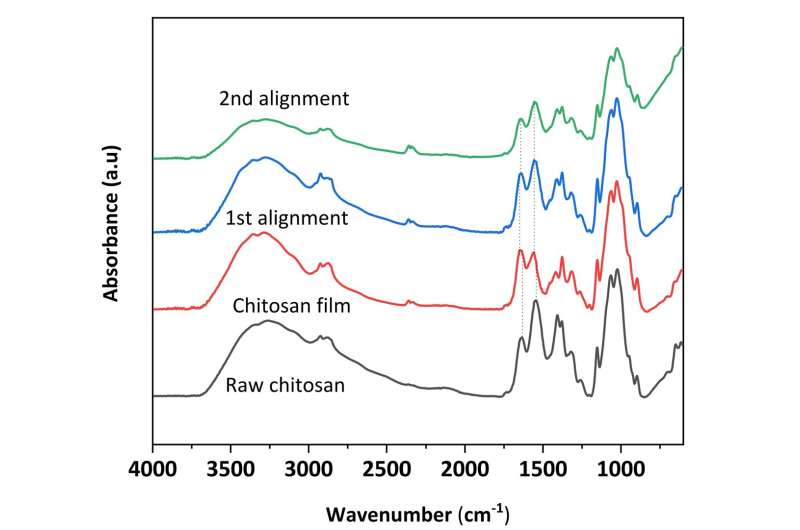This article has been reviewed according to Science X's editorial process and policies. Editors have highlighted the following attributes while ensuring the content's credibility:
fact-checked
peer-reviewed publication
trusted source
proofread
A butterfly's first flight inspires a new way to produce force and electricity

The wings of a butterfly are made of chitin, an organic polymer that is the main component of the shells of arthropods like crustaceans and other insects. As a butterfly emerges from its cocoon in the final stage of metamorphosis, it will slowly unfold its wings into their full grandeur.
During the unfolding, the chitinous material becomes dehydrated while blood pumps through the veins of the butterfly, producing forces that reorganize the molecules of the material to provide the unique strength and stiffness necessary for flight. This natural combination of forces, movement of water, and molecular organization is the inspiration behind Associate Professor Javier G. Fernandez's research.
Alongside fellow researchers from the Singapore University of Technology and Design (SUTD), Fernandez has been exploring the use of chitinous polymers as a sustainable material for engineering applications.
In their latest study, "Secondary reorientation and hygroscopic forces in chitinous biopolymers and their use in passive and biochemical actuation," published in Advanced Materials Technologies, the research team shed light on the adaptability and molecular changes of chitinous materials in response to environmental changes.
"We've demonstrated that even after being extracted from natural sources, chitinous polymers retain their natural ability to link different forces, molecular organization, and water content to generate mechanical movement and produce electricity without the need for an external power source or control system," said Fernandez, highlighting the unique features that make chitinous polymers energy-efficient and biocompatible smart materials.
Chitin is the second most abundant organic polymer in nature after cellulose and is part of every ecosystem. It can be readily and sustainably sourced from multiple organisms, and the same SUTD research team has demonstrated that it can be sourced even from urban waste.
In the current study, the researchers extracted chitinous polymers from discarded shrimp shells to create films that are about 130.5 micrometers thick. They investigated the effects of external forces on these chitinous films, focusing on changes in molecular organization, water content, and mechanical properties. The researchers observed that similar to the unfolding wings of butterflies, stretching the chitinous films reorganized the crystalline structure—the molecules became more tightly packed and the water content decreased.
Originally with characteristics similar to commodity plastics, the chitinous films were transformed to a material resembling plastics for high-end and specialized engineering purposes. Unlike the inert nature of synthetic polymers, the reorganized chitinous films could autonomously relax and contract in response to environmental changes, similar to how some insects adapt their shell to different situations. This ability enables the chitinous films to lift objects weighing over 4.5 kilograms vertically.
To demonstrate the engineering applicability of the biocompatible films, the research team assembled them in a mechanical hand. By controlling the intermolecular water of the films through environmental changes and biochemical processes, the team created enough force for the hand to display a gripping motion. Impressively, the gripping force was equivalent to 18 kilograms—more than half the average grip strength of an adult.
The ability to produce such force through biochemical means also suggests the potential seamless integration of chitinous films into biological systems and their suitability for biomedical applications, such as artificial muscles and medical implants.
In a different demonstration, the team showed that the response of the material to humidity changes could be used to harvest energy from environmental changes and convert it into electricity. By attaching the films to a piezoelectric material, the mechanical motion of the films in response to humidity changes was converted into electrical currents suitable to power small electronics.
Fernandez's proof-of-concept study illustrates how both the native mechanical characteristics and embedded functionalities of chitin can be reproduced, emphasizing the potential use of chitin in engineering and biomedical applications. He opines that materials like chitin play a vital role in the transition to a more sustainable paradigm, which he terms as the biomaterial age.
"Chitin is used for many complex functions in nature, from making the wings of insects to forming the hard protective shells of mollusks, and has direct engineering application. Our ability to understand and use chitin in its native form is critical to enable new engineering applications and develop them within a paradigm of ecological integration and low energy," concluded Fernandez.
More information: Balasubramanian Rukmanikrishnan et al, Secondary Reorientation and Hygroscopic Forces in Chitinous Biopolymers and Their Use for Passive and Biochemical Actuation, Advanced Materials Technologies (2023). DOI: 10.1002/admt.202300639
Journal information: Advanced Materials Technologies
Provided by Singapore University of Technology and Design





















